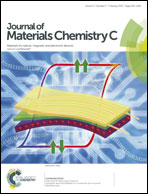Structure and photoluminescence of boron-doped carbon nanoflakes grown by hot filament chemical vapour deposition
Abstract
Boron-doped carbon nanoflakes were directly synthesized by hot filament chemical vapor deposition, nontoxic boron carbide was used as the boron source. The results of scanning electron microscopy (SEM), micro-Raman spectroscopy, Fourier transform infrared spectroscopy (FTIR), X-ray photoelectron spectroscopy (XPS) and transmission electron microscopy (TEM) indicate that boron is effectively doped in the carbon nanoflakes. The number of defects as well as the density of the carbon nanoflakes is increased due to the doping process. The photoluminescence (PL) properties of carbon nanoflakes with and without boron doping were studied at room temperature, the 325 nm line of He–Cd laser was used as the excitation source. The PL results reveal that the carbon nanoflakes with and without doping of boron can generate both weak blue and strong green PL bands. The results also show a blue shift of PL bands and an enhanced PL intensity after boron doping. This is attributed to an increase in the band gap of carbon nanoflakes upon boron incorporation. These results improve our knowledge of the synthesis and optical properties of graphene-based materials and contribute to the development of graphene-based optoelectronic devices.


 Please wait while we load your content...
Please wait while we load your content...